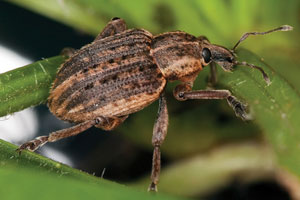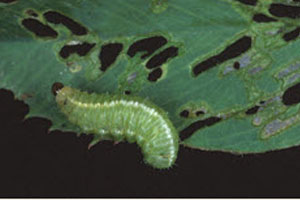
Detecting the weevil by scouting and knowing what to look for is the first step to reducing the damage it can cause. Once identified, a producer can evaluate management steps to control it.
Identification is key
Generally, weevils become active in April and are readily observable by early June. These small, yellow-green larvae have a white stripe down the middle of their backs and can grow to be three-eighths of an inch long.

Transformation into an adult occurs in a pea-sized, loosely woven, white cocoon attached to an alfalfa leaf. Adult alfalfa weevils grow to be about a fourth of an inch long and have a distinctive dark, narrow stripe extending down their backs.
While weevils are small and can be hard to spot, the damage they cause is visible. Both adults and larvae feed on alfalfa foliage; however, larvae cause the most damage. Initially, larvae feed on terminal leaves, and as the season continues, they move to lower foliage.
The feeding pattern begins with pinholes in terminal leaves early in the season; leaves will look skeletonized. As the first cutting nears, larvae begin feeding between the veins and on buds and growing tips, causing even more damage.
Adult weevils also damage fields, generally feeding on leaf margins, which give foliage a feathery appearance. These injured leaves dry out quickly and lend fields a grayish to whitish cast resembling frost damage.
Scouting and sampling
While alfalfa weevils can cause a great deal of damage, scouting and sampling once a week can lead to informed management decisions and a reduction of the negative effects. Consider following these procedures from the Pioneer Silage Zone Resource Manual:
- Scout the field in a U- or Z-shaped pattern, avoiding field edges. Choose, and place in a bucket, at least 30 stems from the U- or Z-shaped path.
- Then return to the edge of the field and lay the stems on a clean, flat surface. The hood of a truck works just fine.
- Beat four or five stems at a time against the inside of the bucket to dislodge larvae.
- Count all larvae and record the number.
- Continue this procedure until all stems have been shaken. If three or more weevil larvae per stem are found, a management decision must be made quickly.
One management choice is to harvest the first hay crop as early as possible. Studies show harvesting can reduce pest populations by 95 to 98 percent.
Another option is applying an insecticide. If this second choice is selected, do not apply during bloom due to potential harm to non-target insects, such as honeybees.
While both tactics reduce the alfalfa weevil population, carefully monitor regrowth four to six days after harvest for any sign of continued damage. Early cutting concentrates survivors in windrows; thus, both alfalfa weevil larvae and adults have the potential to affect regrowth by feeding on new shoots.
If regrowth has been compromised by two or more larvae per crown, a stubble spray is warranted.
Detection is key
If undetected, alfalfa weevils can severely damage the season’s first alfalfa crop. But if producers are aware of the signs, skeletonized and/or grayish leaves, they can minimize the damage. Remember: detection is key to controlling alfalfa weevils. FG
—Information provided by DuPont Pioneer







